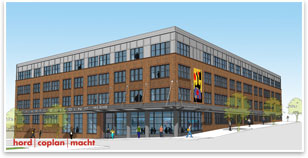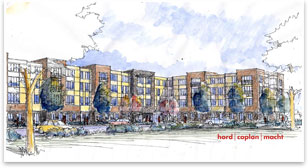Hord Coplan Macht Buoys Bottom Line with Stimulus Package Projects
Three ARRA-funded affordable housing projects are keeping them busy
By Zach Mortice
Associate Editor
Summary: The
rush to stimulate the economy with the American
Recovery and Reinvestment Act (ARRA) signed into law in February
placed an emphasis on “shovel-ready” projects that can
be put into the ground rapidly, precluding much design, and, it’s
been feared, precluding architects. But one Baltimore firm has already
seen the health of their business buoyed by projects deemed “design-worthy” of
ARRA stimulus funding. Hord
Coplan Macht has recently completed designs for three affordable
housing projects supported by low-income tax credits from the stimulus
package. All of these projects existed as proposals before the stimulus
package passed, but Hord Coplan Macht designed them on a compressed
timeframe in the months following the legislation’s passage,
and they’re all being fast tracked for construction.
These projects have made a stark difference in for the firm, where
the staff of 105 had been cut by 12 percent and the freefalling economy
was forcing them to stare down more reductions. “It’s kept six people working in my office for six months that otherwise might not have been employed,” says Senior Principal Ed Hord, FAIA.

The City Arts Building.
The AIA’s Rebuild and Renew government advocacy plan is largely reflected in the ARRA’s funding for design and construction projects, which the AIA estimates to be $130 billion of the total $787 billion package. The low-income tax credits helping to fund Hord Coplan Macht’s projects are distributed by HUD on a per capita basis and parceled out to individual projects at the discretion of states. The stimulus package allowed Maryland’s public housing agency to assign tax credits to more projects than usual.
Overall, HUD received $4 billion for the energy-efficiency modernization and renovation of public housing facilities from the ARRA. This includes a $3 billion general Public Housing Capital Fund that will be used for building and renovating public housing units and will be distributed by a standard formula. State and local public housing agencies also will be able to compete for a $995 million block of funding. The agency is distributing $600 million for affordable housing energy efficiency upgrades, $200 million to finance stalled projects, and $100 million for general upgrades to affordable housing units—all to be awarded on a competitive basis.
Artists, senior citizens
An early example of ARRA-funded new design work is Hord Coplan Macht’s City Arts Building, an affordable property meant to keep the nucleus of artists living in the Station North District nearby to Baltimore’s Penn Station intact and vibrant. Another nearby property where many artists live is being eyed by developers with the intent to gentrify it, Hord says, likely pricing them out of the neighborhood and making the need for subsidized housing even greater. Hord Coplan Macht’s 79,000-square-foot building is primarily made of brick in a gritty, industrial warehouse aesthetic that relates to the surrounding neighborhood, which is in various stages of abandonment and disinvestment. The building’s 69 units will feature large, combined living room and studio spaces, and the first floor lobby will contain a gallery and event space for residents’ performances and exhibits. Its $9 million dollar price tag (funded by low income housing tax credits) is a prudent investment in the creative class that maintains cities as economically viable engines of culture, Hord says. Jubilee Baltimore, a community development nonprofit, proposed the idea of the City Arts Building and enlisted the help of Homes for America and TRF Development Partners in developing the project.

The Greens at Liberty Road.
The other two affordable housing properties are both senior living facilities. HUD is distributing $95 million specifically for these kinds of projects. The Greens at Liberty Road (in Baltimore County) is a 103,000-square-foot, 105-unit building with a budget of $9.9 million. Low income tax credits from the stimulus package are funding this project, as well as Enterprise Green Communities Grants, distributed by the nonprofit Columbia, Md.-based Enterprise Community Partners.
Enterprise provides financing and technical assistance to developers
and community groups that are building affordable housing. Wayland
Baptist Senior Apartments in Baltimore is a 96,000-square-foot, 90-unit
facility with a budget of $8.5 million. The adjacent Wayland Baptist
Church proposed this building and took control of its site. This
project is also receiving Enterprise Green Communities Grants. These
grants require that projects use certain sustainability systems and
design features, and Hord says both buildings will use 18 percent
less energy than a similar building baseline. The Bon
Secours of Maryland Foundation is also helping to develop the Wayland Baptist
Senior Apartments. Both senior citizen residences will feature lower cabinets, pre-installed grab bars, wider doorways for wheelchair access, and multipurpose spaces for visiting consulting physicians and hair stylists.

Wayland Baptist Senior Apartments.
Use it or lose it
All the projects are on an aggressive design and construction schedule, because if the state doesn’t use the stimulus money quickly, it’s withdrawn. The State of Maryland dictates that all stimulus-funded projects must be completed by February 2012. They are all expected to be under construction by October at the latest. “Normally, from the time they’re awarded, and we were awarded these in March or April, it takes about a year to get them into the ground,” says Hord. “It’s astonishingly quick.”
Hord says that these projects are emblematic of increased reliance on public sector funding for many different kinds of buildings. His firm’s reliance on relatively stable institutional markets, like K-12 education and healthcare, have kept them afloat. Additionally, Hord says, he’s seen HUD working as a loan guarantor in the place of banks for various projects, whether they are affordable housing or not. “People are looking to HUD because banks are not terribly cooperative now.”
|





